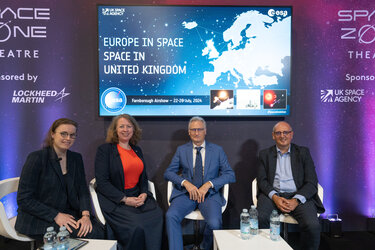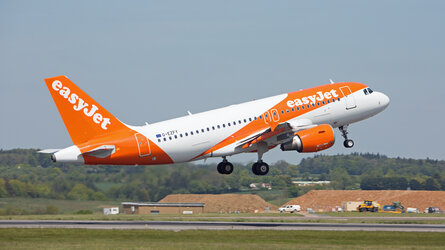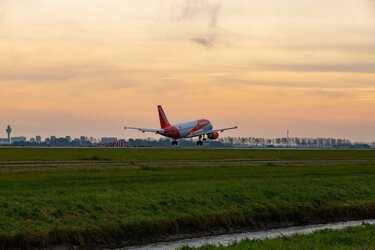Satellite solutions for seamless in-flight internet
In today's connected world, staying online even when travelling at 9000 m is becoming increasingly important. ESA is working to advance in-flight connectivity through satellite technology, ensuring internet access in the air is as seamless as it is on the ground.
ESA has taken a significant step by signing a Memorandum of Intent (MoI) with the Seamless Air Alliance (SAA) on 24 July at the Farnborough International Air Show. The MoI, signed by Laurent Jaffart, ESA Director of Connectivity and Secure Communications, and Jack Mandala, CEO of SAA, aims to revolutionise in-flight connectivity and enhance the travel experience for millions of passengers worldwide.
SAA, founded by leading companies such as Airbus, Delta, Eutelsat OneWeb, Sprint, and Airtel, accelerates the adoption of technologies that allow passengers to use their connected devices (such as smart phones, laptops and IoT devices) seamlessly from lift-off to landing. SAA members include some of the world’s most important companies in aviation and communications, including airlines, satellite and mobile service providers, airframe manufacturers and technology suppliers. By developing standardised connectivity solutions for aircraft, they aim to dramatically improve the quality and reliability of in-flight internet access.
This initiative isn't just about convenience; it's about transforming the entire flying experience. Business travellers can remain productive throughout their journey, turning flight time into efficient work hours. Leisure travellers can enjoy uninterrupted entertainment, from streaming services to online gaming. Airlines that adopt these advanced connectivity solutions can offer personalised services, enhancing customer satisfaction and loyalty.
“The synergy between SAA and ESA will accelerate the development of cutting-edge solutions for in-flight connectivity. This collaboration has the potential to transform air travel, benefiting passengers, airlines, and the broader aviation and space ecosystem,” said Jack Mandala, CEO of SAA.
The goals of the SAA align well with ESA's Space for 5G/6G programme, which is part of ESA’s broader strategy to connect everyone, everywhere. With integrated 5G and advanced 6G technology, ESA aims to overcome connectivity challenges by means of Non-Terrestrial Networks (NTN), which involve space-based and airborne technologies.
By reducing the digital divide and ensuring that high-quality connectivity becomes accessible to all, NTNs could unlock new economic opportunities, improve access to education and healthcare, and support more effective emergency response systems. The technology also holds promise for enhancing environmental monitoring and scientific research on a global scale.
“ESA's expertise in satellite technology, combined with SAA's industry knowledge and network, offers a powerful solution. This partnership will not only improve in-flight connectivity but also contribute to our broader goal to promote a global communications network that isn't bound by traditional infrastructure limitations,” said Laurent Jaffart, ESA Director of Connectivity & Secure Communications.
In addition to Space for 5G/6G, ESA is working to improve other aspects of aviation through the use of space-based technology. Together with communications company Viasat, our Iris programme uses satellite technology to digitally connect pilots with air traffic controllers to optimise flight paths. The aim is for Iris to contribute to shorter flight times and reduced fuel consumption.















 Germany
Germany
 Austria
Austria
 Belgium
Belgium
 Denmark
Denmark
 Spain
Spain
 Estonia
Estonia
 Finland
Finland
 France
France
 Greece
Greece
 Hungary
Hungary
 Ireland
Ireland
 Italy
Italy
 Luxembourg
Luxembourg
 Norway
Norway
 The Netherlands
The Netherlands
 Poland
Poland
 Portugal
Portugal
 Czechia
Czechia
 Romania
Romania
 United Kingdom
United Kingdom
 Slovenia
Slovenia
 Sweden
Sweden
 Switzerland
Switzerland




























